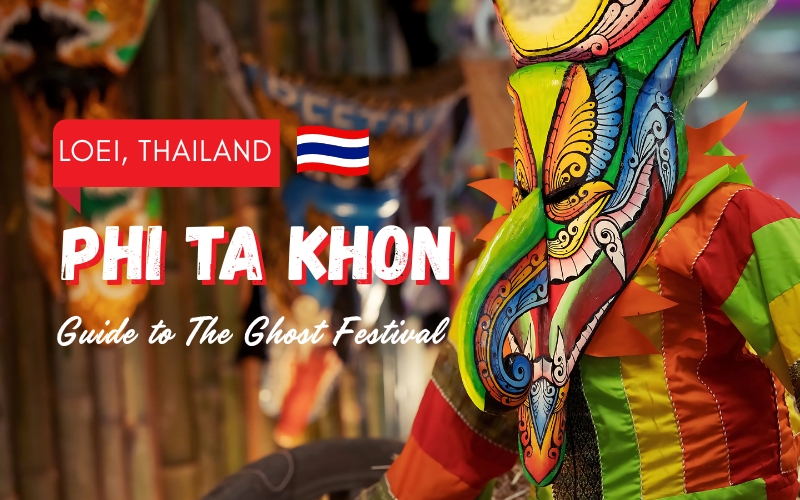
Thailand is famous for its vibrant, colorful and unique festivals, attracting tourists from all over the world. Not as prominent as Songkran, not as gentle as Loy Krathong, Phi Ta Khon brings a unique color to the already diverse culture of Thailand. This ghost festival has a “scary” appearance because of the effigies and masks decorated in the festival, but the story behind it is the meaningful highlight that makes Phi Ta Khon more attractive. Let’s explore with us the fascinating origin of this festival, where and when it is held, as well as its cultural significance.
Overview of Phi Ta Khon
What is Phi Ta Khon?
Phi Ta Khon, the Ghost Festival, is one of the most unique and colorful festivals in Thailand, famous for its colorful masks, traditional music, and lively parades. There are several provinces in the Northeast that also celebrate Phi Ta Khon, but Dan Sai, Loei Province is the most famous and special.
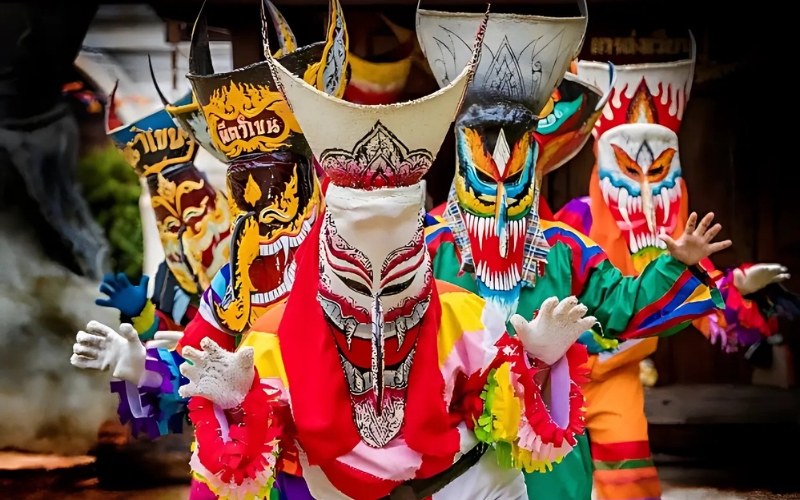
Phi Ta Khon, or Ghost Festival, is one of the most special festivals in Thailand
The festival takes place from late June to early July and usually lasts for 3 days. During these days, townspeople dress up as ghost masks, perform lively dances and gestures, creating a lively and joyful scene along with charming traditional music. This is also the time when people’s creativity comes into play. The masks, with their bright colors and unique features, exude an atmosphere that is both strange and enchanting, and can even become scary, adding to the appeal of the festival. Skillfully crafted from dried rice husks, these masks are usually white and have long noses.
Origin of Phi Ta Khon
Phi Ta Khon is very famous and loved by Thai people for its fun and quirky elements, but despite its long tradition in the Northeast of Thailand, no one can say for sure when or where this festival began. However, we have gathered three theories about the origin of Phi Ta Khon as follows:
- The Legend of Vessantara and Madri: The story of Phi Ta Khon Festival dates back to a long time ago. Prince Vessantara (Buddha in his previous life) went on a long journey to follow the Eightfold Path. It was such a long journey that most of his followers believed that he had died. Surprisingly, one day he returned safe and sound. The people were very happy, and started holding celebrations afterwards so loudly that they even woke up the dead.
- The Legend of Pu Ye-Ya Ye (Mr. and Mrs. Ye): In this legend, there was once a giant tree that reached to the heavens, blocking out the light and plunging the city into darkness, plunging the people into poverty as they could not cultivate anything. One day, an elderly couple named Mr. and Mrs. Ye volunteered to cut down the giant tree with only one request: to remember them when they died. They later succeeded and the city and its people could see the bright sunlight again. Unfortunately, the giant tree fell on the couple, killing them on the spot. To fulfill the couple’s wish, the villagers built a house, where the couple’s hair (called “khon” in Thai) was kept.
- Ancestral Spirits: A third theory suggests that “Phi Ta Khon” comes from the word “Phi Tam Khon” (ghosts following people), which represents spirits who come to the human world in search of food and merit, happily socializing with the living before returning to their own realms. The festival is celebrated as a way to pay homage to the spirits of deceased ancestors, who are believed to have become guardian angels of the city and can bless the earth with fertility or curse it with famine.
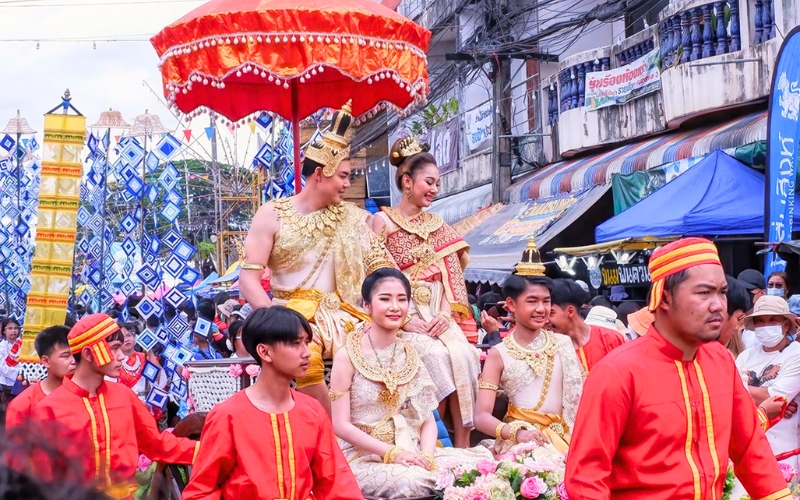
Ceremonial parade honoring the return of Prince Vessantara
Types of masks in Phi Ta Khon
The Phi Ta Khon costume consists of a mask and a skirt. The mask is made from a bamboo steamer, folded into a hat-like shape and punched with holes for eyes, with a long, pointed nose made from a piece of wood resembling an elephant’s trunk, and a horn made from a dried coconut shell. The mask is then painted creatively to look scary but still fun and sophisticated. The skirts are made from scraps of fabric sewn together, decorated with bells, cans tied to the waist or around the neck so that they make noise when walking and dancing. Each Phi Ta Khon must carry a sword or weapon made of wood.
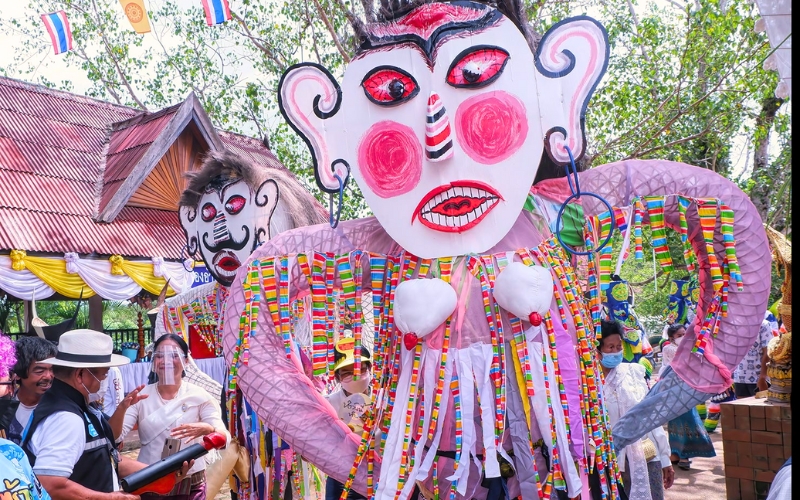
Two Phi Ta Khon Yai, or Big Phi Ta Khon include a male and a female
There are two types of Phi Ta Khon, which are Phi Ta Khon Yai and Phi Ta Khon Lek:
- Phi Ta Khon Yai (Big Phi Ta Khon) is made from a large bamboo frame, twice the size of a person and covered with cloth or paper, with a person operating it inside. Each year, there will be only two Phi Ta Khon Yai, one male and one female, decorated in a way that indicates their gender. Ancient beliefs consider human genitals to be a symbol of fertility, not obscenity. Phi Ta Khon Yai players must be permitted by the spirits to do so and perform this task every year for at least three years. At the end of the day, the Phi Ta Khon Yai costumes must be thrown into the Man River as if to dispel suffering and bad luck.
- Phi Ta Khon Lek (Small Phi Ta Khon) are the festival participants who wear ugly and scary masks. There is no age limit to participate in the festival, from children to adults, all can participate in the parade. In addition, some people can dress up as puppets with animal bodies such as horses, elephants or buffalos and participate in the parade as animals.
Cultural and spiritual significances of the ghost festival
Cultural significance:
- A festival to honor traditions: The Phi Ta Khon Festival is an opportunity for local people to show their respect to the gods, ancestors and deceased spirits. Through this, they also honor the long-standing culture and traditions of the Isan region, where the festival takes place.
- Showing gratitude: The festival is the people’s gratitude to the spirits who have protected and blessed them throughout the past year. They pray that the spirits will continue to bless them in the future.
- Encouraging community cohesion: The Phi Ta Khon Festival is an opportunity for local people to meet, exchange and strengthen solidarity with each other. Everyone participates in fun activities, singing, dancing, creating a bustling and vibrant atmosphere.
Spiritual significance:
- Escape evil spirits: Locals believe that the costumes and masks worn during the festival will ward off evil spirits and bad luck, bringing good luck and prosperity to the community.
- Remembering the spirits: The festival is an opportunity for people to remember and show gratitude to the deceased spirits. They believe that the spirits will return during the festival.
- Seeking purity: Participating in the Phi Ta Khon festival is considered a way to purify the soul, wash away sins and seek purity in the soul.
Phi Ta Khon, the Ghost Festival 2025
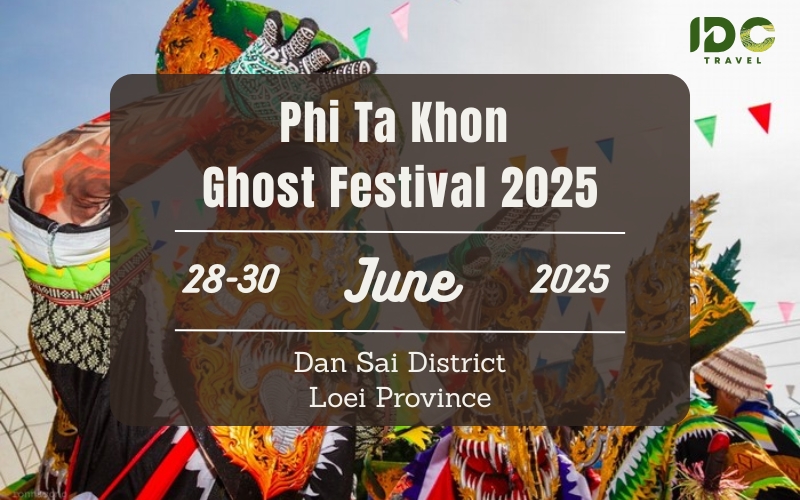
Schedule of Phi Ta Khon 2025
Date: June 28-30, 2025
Location: Dan Sai, Loei province, Thailand
The festival will take place over 3 days, however, to fully experience the festival, you should come on the first and second days to experience most of the activities and the vibrant atmosphere of the festival.
How to get to Dan Sai, Loei
The Phi Ta Khon Festival takes place in Dan Sai town, about 500 km north of Bangkok. You can travel to Dan Sai by many different means, including:
- By plane: This is the fastest and most comfortable way to travel to Dan Sai. Visitors can fly to Loei airport, with regular direct flights during the day from Bangkok and Chiang Mai by airlines such as Nok Air and ThaiAir Asia. The flight time is only about 1 hour, with 3-5 flights per day, making it easy to travel even during the festival season. From Loei airport, you can take a taxi or local bus to Dan Sai. Public transport is usually available more frequently around the festival days, but seats can fill up quickly, so booking in advance is recommended.
- By bus: There are many bus companies providing transportation services from Bangkok and other cities to Dan Sai. This is a cost-effective way to travel but the travel time will be quite long, about 8-10 hours. While some buses may take you directly to Dan Sai, most stop in Loei city, where you will need to transfer to a local minivan or songthaew (shared pickup truck taxi) for the final leg to Dan Sai. However, this is also an opportunity for you to see the Thai countryside and interact more with the locals and ideal for backpackers or those wanting to experience local-style travel.
- Tip : During the Phi Ta Khon festival (usually in June or July), extra services may be added, but early booking is still advised.
- By train: You can take the train departing daily from Bangkok to Phitsanulok Railway Station, which takes about 6-7 hours. From here, you can take a bus or taxi to Dan Sai for about 3 more hours. This is more suitable for travellers who want to experience a relaxing trip, when you get off the station you can spend some time exploring Phitsanulok, a famous historical town in Thailand.
- By car: Driving to Dan Sai is a great option for travellers who want to travel privately, comfortably and still have time to enjoy the scenery along the way. The travel time by car from Bangkok to Dan Sai is about 6-8 hours with the most popular routes passing through Lopburi, Phetchabun, or Phitsanulok, offering chances to visit cultural sites, waterfalls, and mountain viewpoints along the way. You can rent a self-drive car (international driving license required) or a private car with driver for a relaxing time. Our service is a great option — especially if you’re traveling in a group or with family.
> > > If the magic of Phi Ta Khon leaves you wanting more, why not extend your journey and explore the diverse wonders of this beautiful country with our Thailand tours, from ancient capitals and misty mountains to idyllic beaches and vibrant cities?
How is Phi Ta Khon celebrated?
Day 1: Phi Ta Khon Day – Phra Upakhut Summoning
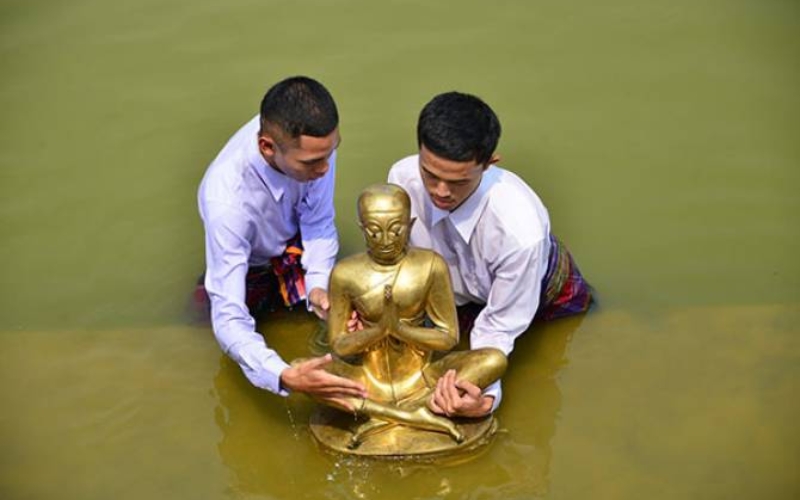
The river ceremony mark the beginning of Phi Ta Khon
The main event of the day is the summoning of Phra Upakhut, a Buddhist monk who attained enlightenment and became an Arahant. King Asoka wanted to successfully celebrate the completion of 84,000 temples and pagodas, so he summoned Phra Upakut to protect the celebration from evil spirits.
During the ceremony, the villagers build the Upakhut Hall and perform a symbolic dialogue. One person will have to stand in the river and another person on the river bank praying. The person in the water must pick up a stone from the river and ask the other person “Isn’t that Phra Upakhut?” The person standing on the bank must answer “No”. Repeat the whole action three times and change the stone. The third time, the person on the bank will answer “Yes, that is the real Phra Upakhut”. After the ceremony, fireworks and firecrackers are set off to awaken the Phi Ta Khon, inviting them to join in the festival.
Day 2: Phi Ta Khon Parade – Prince Vessandorn Returns to Town
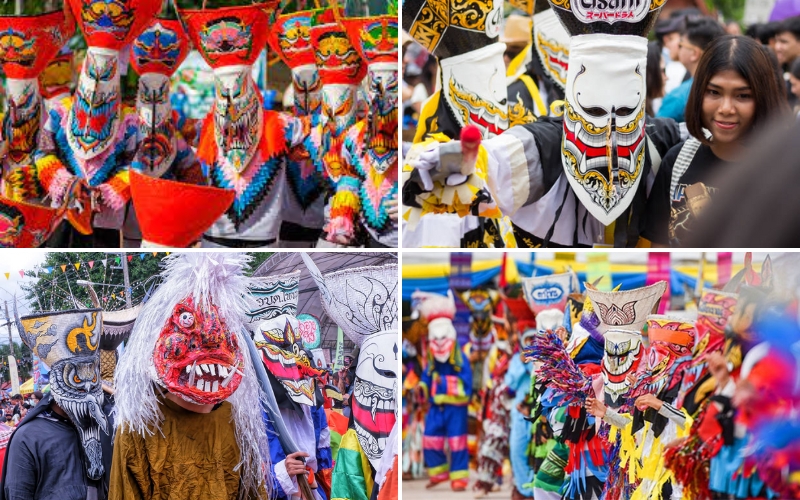
Highlight of Phi Ta Khon, the grand parade
On this eventful day, Prince Vessandorn and Phra Upakhut make their triumphant return to town, marking the start of the vibrant Phi Ta Khon Parade. The streets come alive with a lively parade, with locals wearing distinctive masks with unique designs. Street vendors sell these masks, allowing visitors to fully immerse themselves in the festival by wearing them and joining the joyous crowds.
As dusk falls, the locals return home, removing their elaborate disguises and gathering for a late dinner. They reflect on the joyful moments of the day, exchanging wishes for happiness and prosperity for the days ahead.
Day 3: Ancestors Day – Temple Traditions
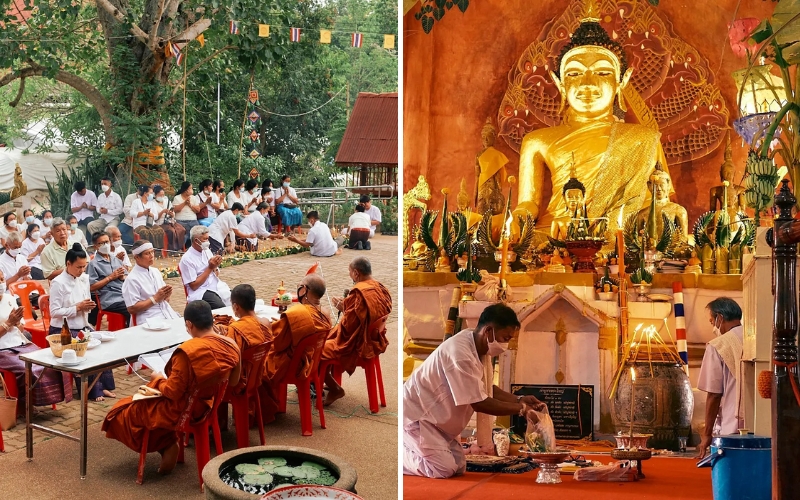
Devotees gathering at Wat Phon Chai on Ancestors Day
The following day is dedicated to honoring ancestors through a series of solemn ceremonies held at local temples. Devotees pray, make merit, and perform good deeds in memory of their deceased relatives. They pay their respects by attending Thet Mahachat sermons recounting the life of the Buddha, worshipping holy relics in the temple grounds, and making offerings to monks.
Notes when attending the festival
Phi Ta Khon Ghost Festival is a unique and vibrant festival that attracts visitors from all over the world. However, to have a complete and safe festival experience, you need to note the following:
- Planning: Phi Ta Khon Festival 2025 takes place on June 28-30. Since Dan Sai is a small town, the number of rooms and transportation may be limited and fill up quickly. Therefore, book your flight and hotel early to avoid running out of space.
- Arrive early: If possible, arrive 1 day before the festival starts to rest, get acquainted and explore the town. You also have the opportunity to observe the pre-festival preparations of the locals, providing a more intimate experience.
- Attire: Although there is no dress code requirement, you should wear polite and comfortable clothes, covering your skin carefully because the weather can be quite hot. Bring a hat, cap, sunscreen and sunglasses to protect yourself from the sun. Don’t forget to pack a light raincoat as well, as June is the rainy season in Thailand.
- Cash: Some vendors at the festival may not accept card or bank transfer payments, so bring enough cash.
- Respect the culture: Phi Ta Khon is an important religious festival for the locals, with many unique rituals and customs. Take the time to learn more about the meaning of the festival and avoid disrespectful actions.
- Keep order: The festival attracts a lot of participants, so keep order and follow the instructions of the security staff. Also, keep the environment around the festival clean by not littering.
- Be careful with your personal belongings: The festival can be very crowded, so be careful with your personal belongings. Use a crossbody bag or waist pouch and avoid flashing valuables.
Above is interesting information about the Phi Ta Khon festival, which is somewhat scary but also has a humane element. Phi Ta Khon, or Ghost Festival, is definitely one of the most attractive and unique festivals that you should experience when visiting Thailand. If you are planning to visit Thailand this June, do not miss the opportunity to attend one of the most wonderful festivals in Thailand, Phi Ta Khon. Contact us today to plan to participate in this festival, immerse yourself in the bustling atmosphere and learn about the culture and beliefs of the Thai people.
Read more:
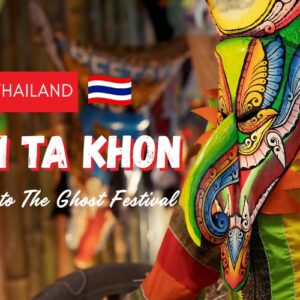
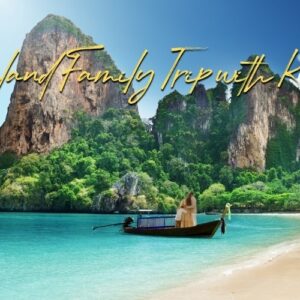


The mask designs are insane in the best way! I didn’t realize each one had a personal touch and story behind it. It would be awesome if there were mini mask-making classes during the festival. Do locals ever sell their handmade ones as souvenirs?
Dear Lexie,
Thank you so much for your thoughtful comment! We’re glad you appreciated the artistry behind the masks — each one truly tells a story. Yes, many locals do sell their handmade masks during the festival, ranging from full-sized to smaller souvenir versions. While there aren’t official mask-making classes yet, some local artisans may offer hands-on experiences if arranged in advance. We’d be happy to help with that!
Best regards,
IDC Travel Team.